Types of Air Pollution
- The book “Environmental Science” identifies the major substances that are released into the nature atmosphere.
- Primary pollutants include gases and volcanic ash. Carbon oxides such as CO2 and CO are colorless.
- Carbon monoxide (CO) is usually toxic and affects animals and plants.
- Nitrogen oxides such as NO2 and NO are greenhouses gases capable of producing acidic rain.
- Some particulates such as dust and volcano ash can result in smog (Enger & Smith, 2016).
- The second category includes secondary pollutants.
- Smog occurs when “car exhausts are exposed to direct sunlight” (Hitchcook, Conlan, Kay, Brannigan, & Newman, 2014, p. 17).
- Enger and Smith (2016) identify hazardous compounds as potential sources of pollution.
- Some of these compounds include chemicals and toxic compounds (Enger & Smith, 2016).
- Cleaners, glues, and gasoline also pollute the atmosphere.
- Perchloroethylene is released from cleaning agents.
The first group or type include primary pollutants and emerge from natural processes or human activities. These primary pollutants include gases and volcanic ash. Carbon oxides such as CO2 and CO are colorless. Carbon monoxide (CO) is usually toxic and affects both animals and plants. These greenhouse gases affect the global climate. Nitrogen oxides such as NO2 and NO are greenhouses gases capable of producing acidic rain.
The second category includes secondary pollutants. The components of secondary air pollution include ozone and nitrogen oxides. Smog occurs when “car exhausts are exposed to direct sunlight” (Hitchcook, Conlan, Kay, Brannigan, & Newman, 2014, p. 17). Enger and Smith (2016) identify hazardous compounds as potential sources of pollution. Cleaners, glues, and gasoline also pollute the atmosphere. Perchloroethylene is a poisonous pollutant released from cleaning agents.

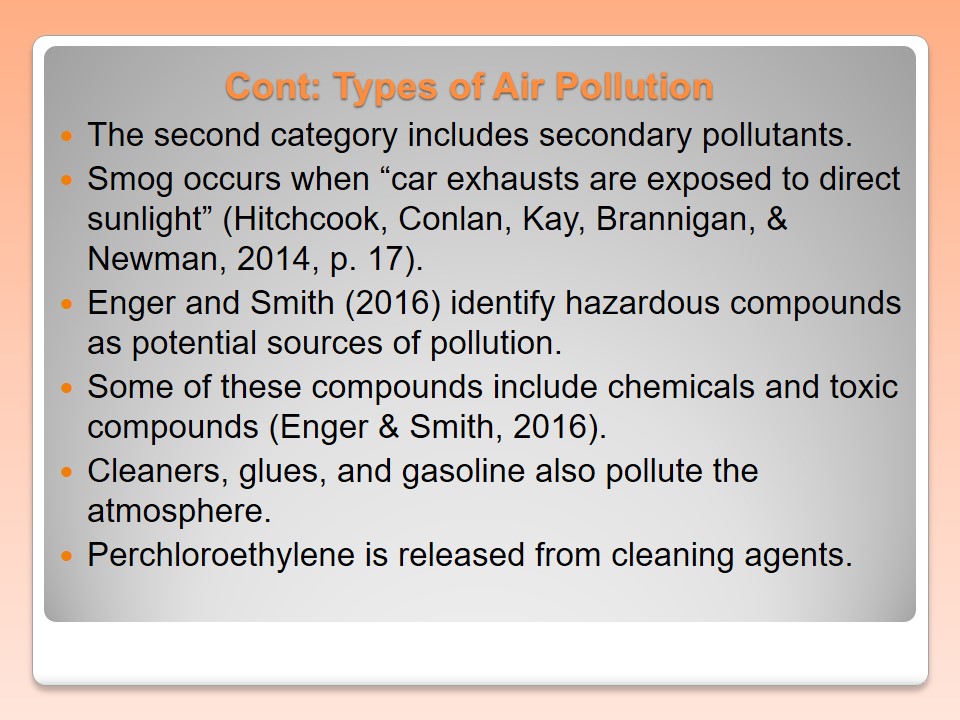
Problems Caused by Poor Air Quality
- The WHO “estimates that urban air pollution accounts for over 3 million deaths annually” (Enger & Smith, 2016, p. 373).
- Unhealthy people die prematurely due to poor air quality.
- Enger and Smith (2016) indicate “that 20-30 percent of all respiratory diseases arises from air pollution” (p. 373).
- During summer periods, smog can become a major problem due to a condition referred to as thermal inversion (Hitchcook et al., 2014).
- The accumulation of harmful chemicals affects people’s quality of health.
- Acid precipitation occurs due to poor air quality.
- Terrestrial ecosystems also suffer due to acid rains.
- Forests have declined significantly due to the connection between air quality and acidic rain.
- Measurements “in the Arctic indicate that the ozone layer has been thinning” (Enger & Smith, 2016, p. 382).
The World Health Organization (WHO) “estimates that urban air pollution accounts for over 3 million deaths annually” (Enger & Smith, 2016, p. 373). Unhealthy, elderly, and young people die prematurely due to poor air quality. The quality of air is affected by the increasing number of industrial plants and motor vehicles. Enger and Smith (2016) go further to indicate “that 20-30 percent of all respiratory diseases arises from air pollution” (p. 373).
Cities with many vehicles are usually associated with smog. During summer periods, smog can become a major problem due to a condition referred to as thermal inversion (Hitchcook et al., 2014). The accumulation of harmful chemicals affects the residents’ quality of health. Acid precipitation occurs due to poor air quality. Terrestrial ecosystems also suffer due to the problem of acid rain. Forests have declined significantly due to the connection between air quality and acidic rain.
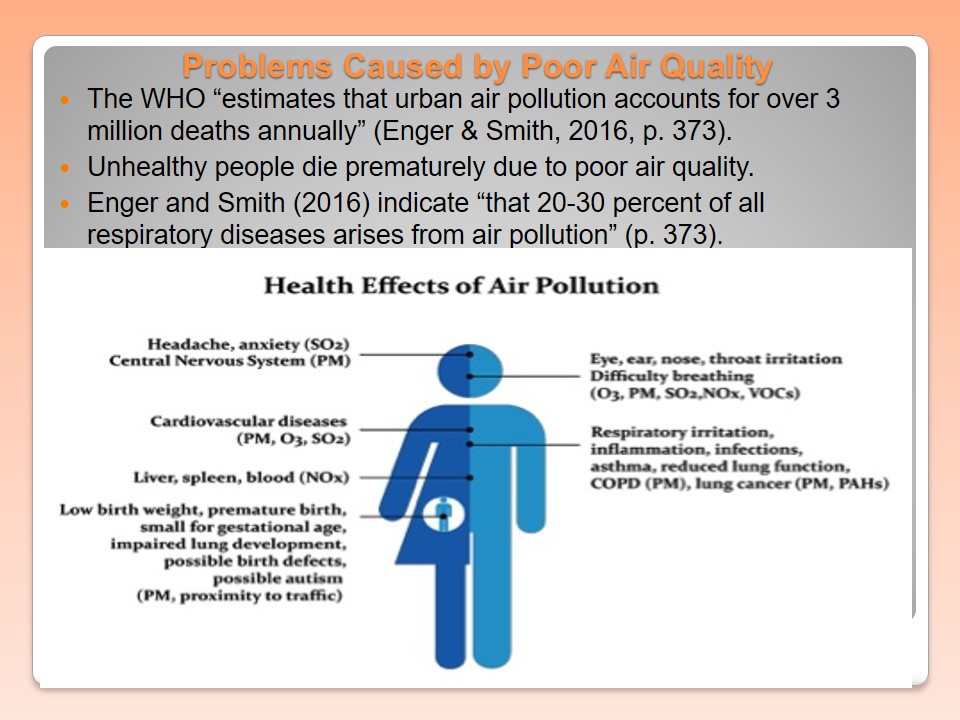
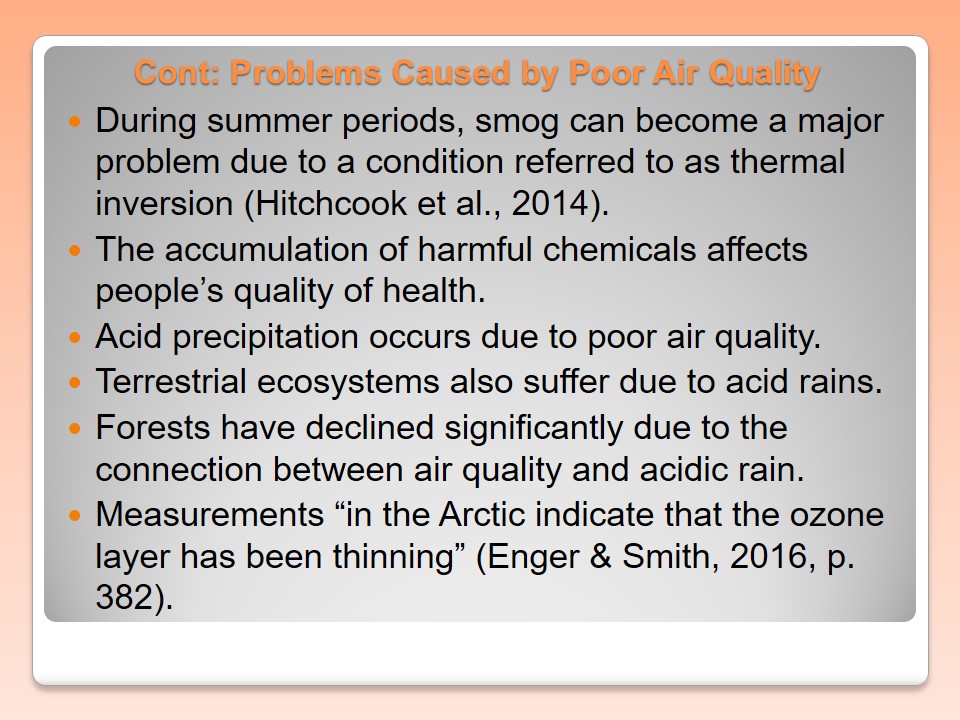
How Human Activity Affects Quality of Air
- Human activities play a significant role towards determining the quality of air.
- Such activities continue to affect the quality of the natural atmosphere.
- Industrial activities produce primary pollutants such as CO2, CO, NO, and NO2 (Enger & Smith, 2016).
- Greenhouses gases are also emitted by industrial processes and vehicles.
- Agricultural and construction activities have led to depletion of natural ecosystems.
- Urbanization and emission of air pollutants have led poor quality of air.
- Agricultural practices have changed within the past five decades.
- Land use and agricultural practices “account for 24 percent of greenhouse gases” (Maji, Ahmed, & Siddiqui, 2015, p. 905).
- For very many years, people have been depending on fossil fuels for energy.
- Some of these fuel sources include coal and crude oil.
- These energy sources affect the cleanliness of the natural environment.
- Human activity therefore remains the leading contributor of air pollution (Enger & Smith, 2016).
- Experts believe strongly that human activities will continue to worsen the problem of air pollution in the near future.
Human activities play a significant role towards determining the quality of air. Man has been engaging in numerous activities that have continued to affect the quality of the natural atmosphere. For example, human economic and industrial activities produce pollutant gases such as CO2, CO, NO, and NO2 (Enger & Smith, 2016). Urbanization and emission of air pollutants have led poor quality of air. Agricultural practices have changed within the past five decades.
Land use and agricultural practices “have been observed to account for 24 percent of greenhouse gases” (Maji, Ahmed, & Siddiqui, 2015, p. 905). For very many years, people have been depending on fossil fuels for energy. These statistics indicate clearly that human activity still remains the leading contributor of air pollution (Enger & Smith, 2016).
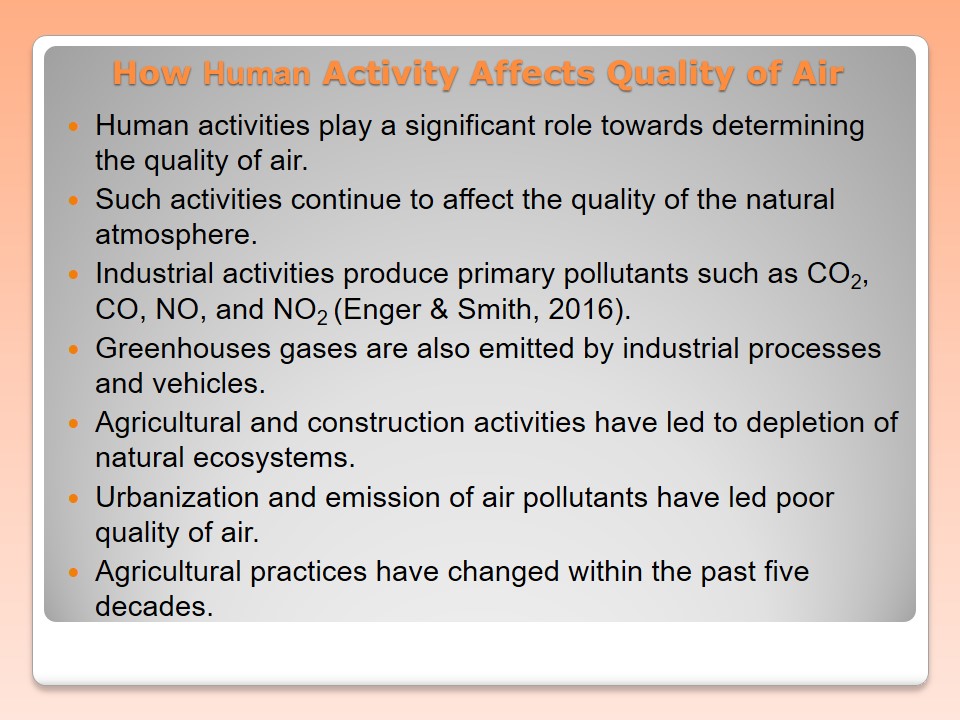
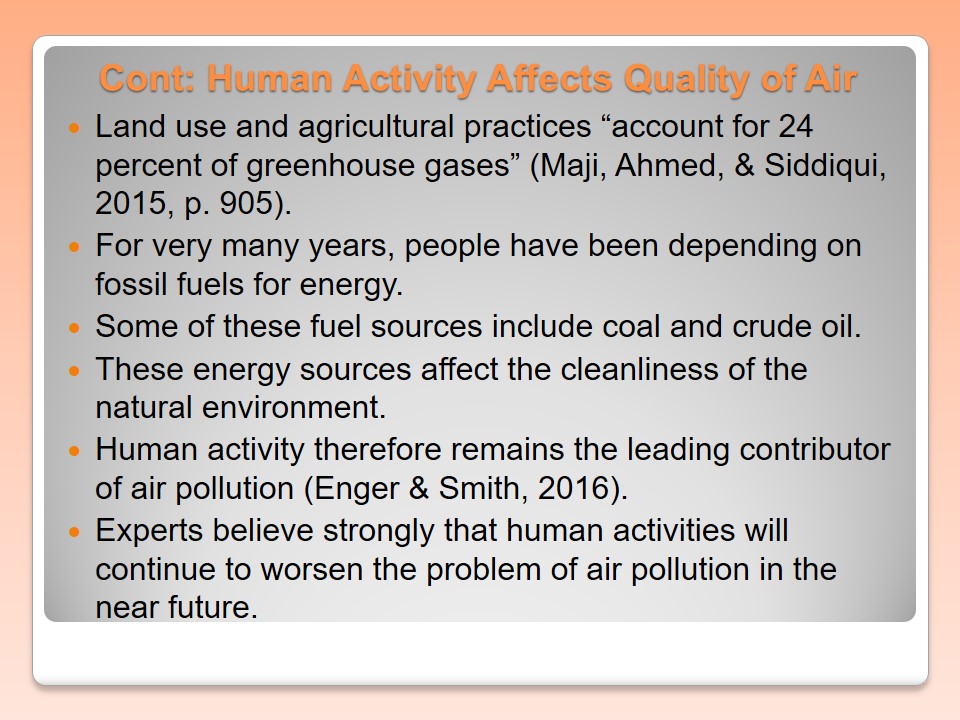
How Human Health is Affected by Air Quality
- Air pollution is associated with both short-term and long-term health complications that can cause sudden death.
- The WHO indicates that SO2 and NO2 can cause eye irritation and damage the respiratory system.
- Prolonged exposure can cause lung or cardiovascular problems.
- Lung cancer is also associated with poor air quality (Enger & Smith, 2016).
- Over 2 million human beings die annually due to air pollution.
- Individuals living in polluted homes have increased chances of developing health complications.
- Indoor pollutants such as paints and household cleaners can cause asthma in children.
- Prolonged exposure to indoor pollutants is capable of causing cardiovascular disease, asthma, pulmonary problems, and cancer (Maji et al., 2015).
- Individuals who have preexisting diseases such as cancer or pulmonary conditions are also vulnerable.
- Regions that are identified as green have also been associated with reduced life expectancy (Currie, 2013).
- According to the WHO, life expectancies will be shortened by around 8 months due to air pollution.
Air pollution is associated with both short-term and long-term health complications that can cause sudden death. The WHO indicates that SO2 and NO2 can cause eye irritation and damage the respiratory system. Prolonged exposure can result in various lung or cardiovascular problems. Lung cancer is also associated with poor air quality (Enger & Smith, 2016). A study conducted by the WHO indicated that over 2 million human beings were dying annually due to air pollution.
Prolonged exposure to indoor pollutants is capable of causing cardiovascular disease, asthma, pulmonary problems, and cancer (Maji et al., 2015). Individuals who have preexisting diseases such as cancer or pulmonary conditions are vulnerable to the above effects of poor air quality (Currie, 2013). According to the WHO, life expectancies will be shortened by around 8 months due to the major problems arising from air pollution.
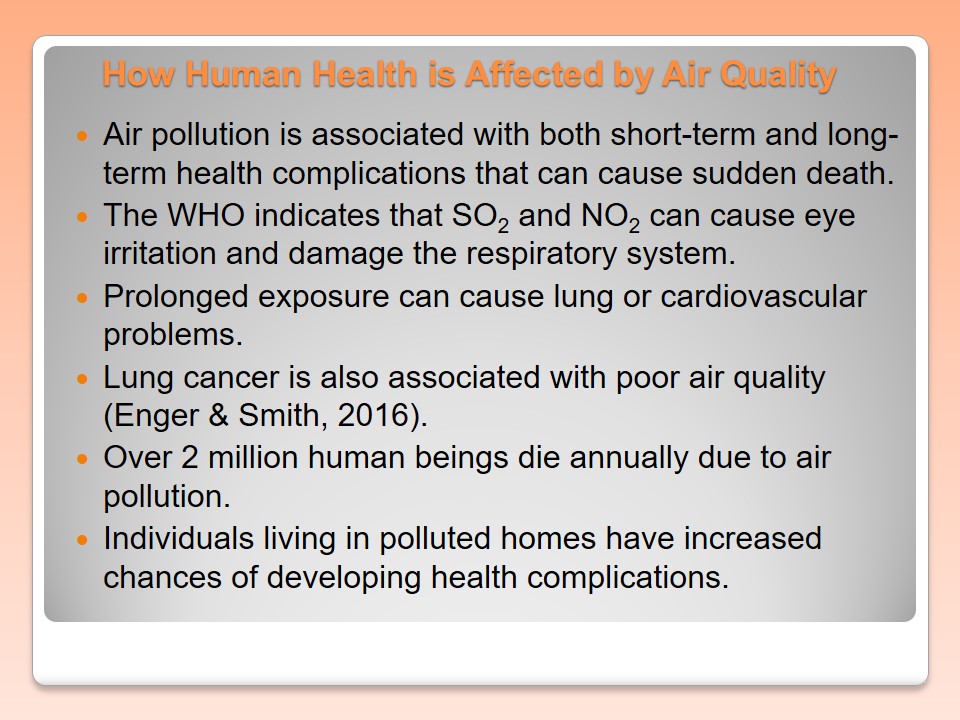
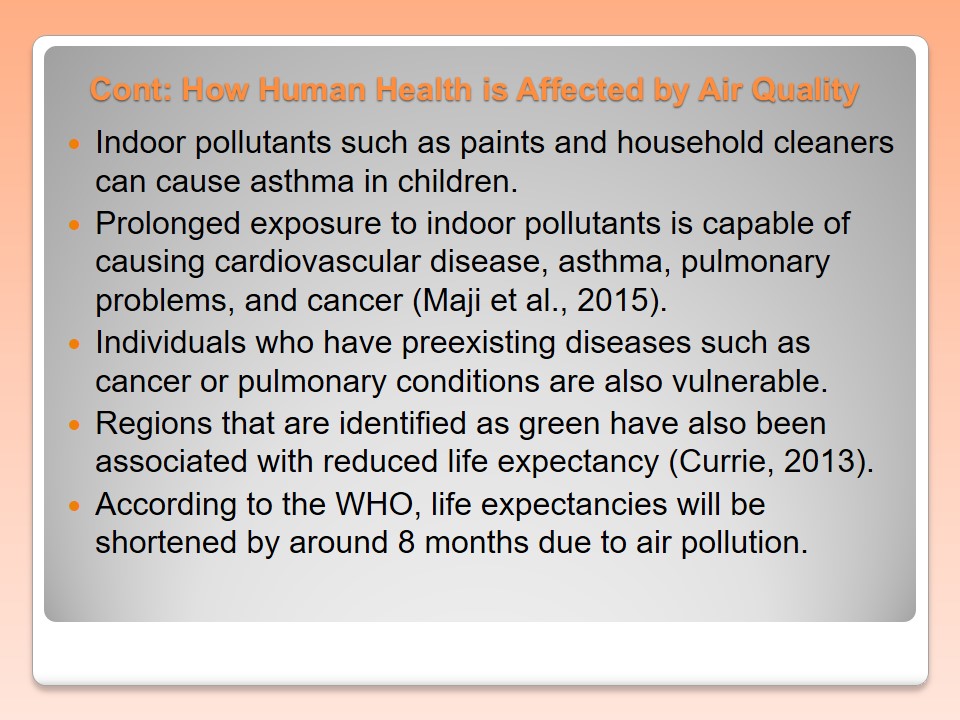
Plausible Suggestions to Improve Air Quality
- Legislation:
- The government can implement stringent laws to dictate various human activities (Egondi et al., 2013).
- Companies should engage in environmentally-friendly manufacturing processes.
- Vehicle manufacturers should ensure their cars do not pollute the environment.
- Chemical manufacturers should produce detergents and cleaners that do not emit poisonous compounds (Vallero, 2014).
- Sustainability:
- Green practices can guide more people to recycle different materials and minimize their ecological footprints.
- Energy saving tips can minimize the quantities of gases emitted through various human activities (Maji et al., 2015).
- Farmers should embrace the use of biodegradable and organic compounds.
- Pesticides and fertilizers should be environmentally-friendly (Egondi et al., 2013).
- New campaigns should be used to promote greener and sustainable practices.
The government can implement stringent laws to dictate various human activities (Egondi et al., 2013). For instance, companies should be required to engage in environmentally-friendly manufacturing processes. Vehicle manufacturers should ensure their cars do not pollute the environment. Chemical manufacturers should be monitored in order to produce detergents and cleaners that do not emit poisonous compounds.
Enger and Smith (2016) believe that green practices can guide more people to recycle different materials and minimize their ecological footprints. Energy saving tips can minimize the quantities of gases emitted through various human activities (Maji et al., 2015). Farmers should embrace the use of biodegradable and organic compounds. Pesticides and fertilizers, for instance, should be environmentally-friendly.
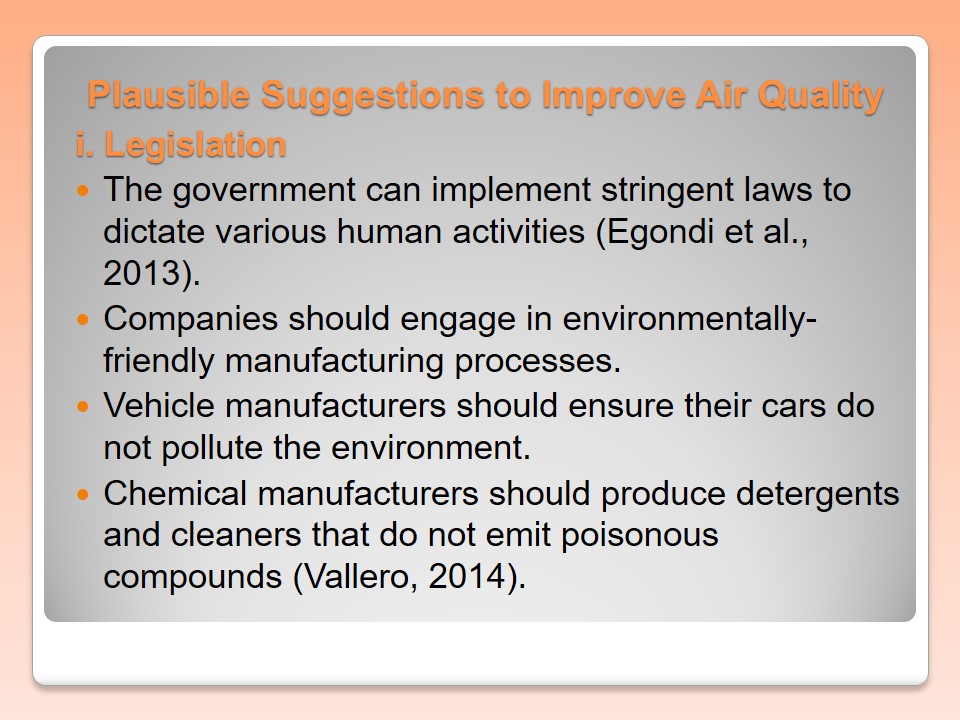
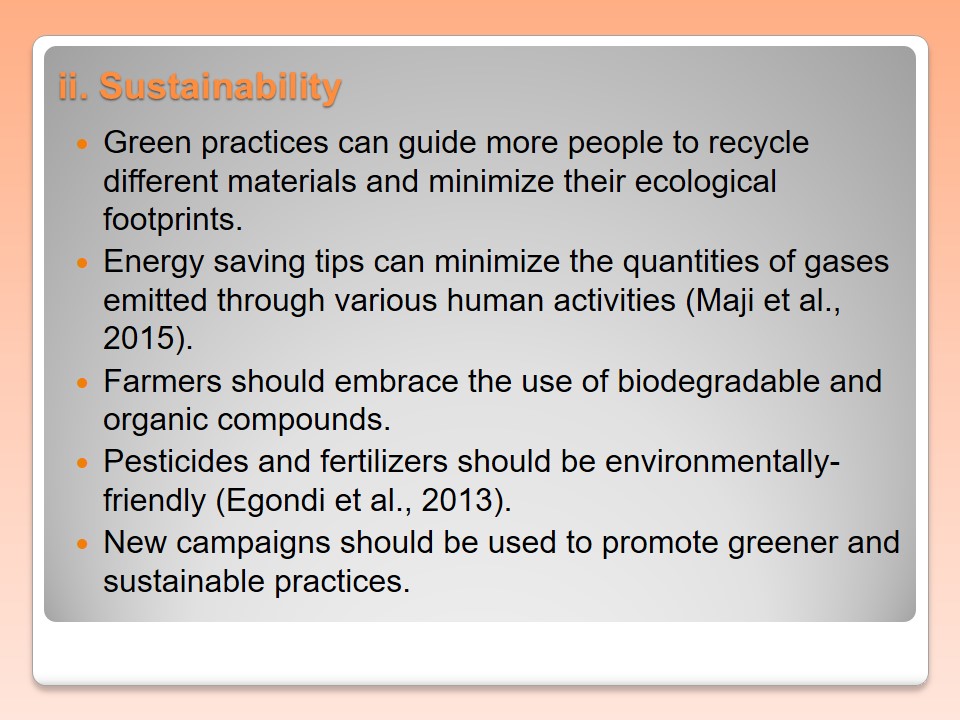
References
Currie, J. (2013). Pollution and infant health. Child Development Perspectives, 7(4), 237-242.
Egondi, T., Kyobutungi, C., Ng, N., Muindi, K., Oti, S., de Vijver, S., & Rocklov, J. (2013). Community perceptions of air pollution and related health risks in Nairobi slums. International Journal of Environmental Research and Public Health, 10(1), 4851-4868.
Enger, E., & Smith, B. (2016). Environmental Science. New York, NY: McGraw Hill.
Hitchcook, G., Conlan, B., Kay, D., Brannigan, C., & Newman, D. (2014). Air quality and road transport: Impacts and solutions. RAC Foundation, 1(1), 1-45.
Maji, S., Ahmed, S., & Siddiqui, W. (2015). Air quality assessment and its relation to potential health impacts in Delhi, India. Current Science, 109(5), 902-909.
Vallero, D. (2014). Fundamentals of Air Pollution. New York, NY: Academic Press.